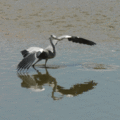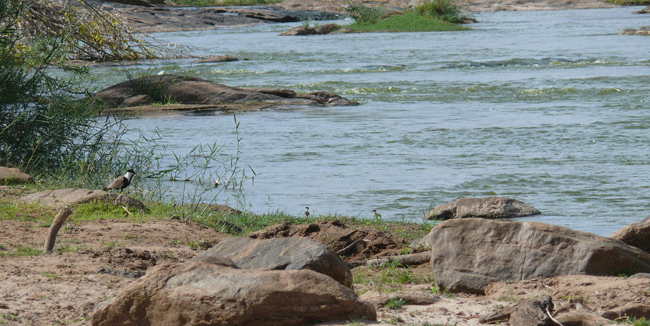1st November 2007
 Wednesday, November 21, 2007 at 09:00AM
Wednesday, November 21, 2007 at 09:00AM I could not resist going back to the now empty plover nest in the afternoon, just to ensure both chicks had made it through the night – and sure enough, there they were, the two tiny little mites, down by the river, safely with one of their parents watching over them. Sometimes there really are happy endings…
It does seem to be the season for babies, which makes sense with the rains approaching (we hope). While I was with the plovers, a Dik-dik emerged and was soon followed by its baby, which hid in the reeds, while the parent was feeding there. Many antelopes do this – leave their babies hidden somewhere, sitting absolutely still – while the parents go off to feed.
The Yatta has turned green with the mist and isolated rain showers…we’ve been watching in envy as the plateau receives more rain than we do. I took some shots of the Yatta while on a bit of a Baobab photographing spree.
Back at the house, life continued busily throughout the day: the Egyptian Geese chicks – still all six – continue to grow, and are almost their parents’ size now; a large male Warthog spent a few hours foraging on the edge of the sandbank (how nice to see him there); the Grey Heron was hunting in fairly deep water, occasionally launching itself lightning fast - if somewhat inelegantly which is unusual from this most elegant of birds - into the water to catch a fish (or not, as the case seemed to be); a baboon visited one of the islands in the evening to feed on the reeds which are flowering and seeding, leaving the rest of his troop on the bank; the Village Weavers were busy stripping greenery from the reed islands as well, perfect building material for their inland nests, and the African Golden Weaver could be seen on its own nest in the same reed bed; the hippo too was making the most of the reed-fest, and (despite our noisy water pump running just across the river from it), was feeding for a long time right out in the open in full view, along with its baby who was alternately feeding on the reeds and playing. Hippos are strangely designed creatures, for their huge teeth serve no purpose when feeding: instead the hippo merely rips out grass (or reeds) with its lips, and swallows it – no chewing involved.

Egyptian Goose Family (click any image to enlarge)

Grey Heron fishing

Mother & Baby Hippo feeding on reeds
An animal which most definitely chew is the porcupine, with its large rodent teeth. The porcupine who visits us late at night to pick up whatever scraps from the kitchen I can find for it (cabbage leaves, carrots, broccoli stems) seems to have a baby too, judging by the size of the quill we found alongside the adult quills. How I’d love to see it, but it does not come visiting until we are in bed and all the lights are out.
The bird table continues to be an ever-growing success, and my lilies are thriving – soon there will be a small jungle of them on the balcony flowerbed. It will be exciting to see what colour their flowers are, when the time comes. The Ipomea creeper we planted just inside the front door is doing well too.
Grace and Samson started work with us today. On my way to collect them and their belongings, I passed a large flock of Vulturine Guinea Fowl, quite the most spectacular and beautiful of birds. You can see by the shape of their heads exactly why they were named ‘vulturine’. How they can remain camouflaged with their electric blue feathers is incredible; see how easily their streaky plumage merges with the backdrop? It’s amazing what tricks nature can play with colours and camouflage.
I also passed several flocks of Helmeted Guineafowl, which are more common – the same as the large flock that congregates every morning on our sandbank. I didn’t manage to get any decent photographs of them, but will be sure to get some as soon as I can, for comparison with their Vulturine cousins.
The other kinds of fowl-type birds we get here include the Crested Francolin (we have several who are getting very tame in the commiphora thicket behind the house), and the Yellow Necked Spurfowl, which are very common in the Kenyan bushland, and which we hear calling a lot, but for some reason don’t see very often on our own land.







Reader Comments